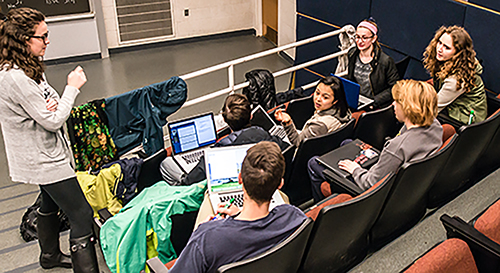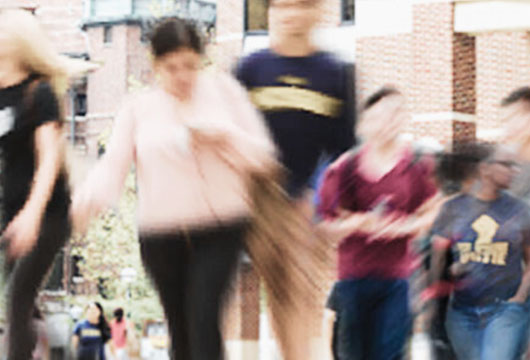
In scientific research, rigor refers to the level of care and precision used in the design, execution, and interpretation of experiments and studies. For example, the National Institute of Health (NIH), a major funding source for medical and biological sciences, requires grant applications and progress reports to adhere to a strict standard of rigor. In this setting, scientific rigor is defined as: “the strict application of the scientific method to ensure unbiased and well-controlled experimental design, methodology, analysis, interpretation and reporting of results.” While this definition is STEM specific, descriptions of rigor in other disciplines also focus on thoughtfully executing one’s work, ensuring it is grounded in scholarship, and examining one’s biases in analysis and interpretation (e.g., see Gill & Gill, 2020; Langtree, Birks, & Biedermann, 2019; and Riggs & Büchler, 2007).
How might we conceptualize rigor in a college teaching setting? At a minimum, it would involve thoughtfully chosen, clearly laid out learning goals, targeted assessments of those goals, and learning activities designed for students to reach those goals, independent of student demographic or background. The design and implementation of a rigorous course would be grounded in the scholarship of teaching and learning for the discipline. Additionally, an indicator of rigor would measure how many students (and by how much) have pushed the boundaries of their knowledge, skills, and attitudes in order to meet the course objectives.
Unfortunately, the term “rigor” has traditionally been used in a different way, to justify instructor behaviors that can hinder learning and perpetuate inequities (Campbell et al., 2018; Nelson, 2010). “Faculty members often look to the wrong indicators as evidence of [rigor]. Giving students a boatload of work doesn’t mean a course is rigorous. Neither does the grade distribution.” (Supiano, 2021).
Academic rigor can promote equity by setting high expectations for all students (regardless of their background), and providing them with the support and resources they need to meet those expectations (Bowman & Culver, 2018).
“It is crucial…that rigorous courses address inequities. If some students perform poorly because they were less prepared or familiar with the ins and outs of college, that also doesn’t show that a course is rigorous. It shows that students were insufficiently supported. There’s a whole literature showing disadvantaged students perform on par with their peers when those barriers have been addressed.” (Supiano, 2021).
What kinds of approaches to teaching will motivate all students to ask questions and push their knowledge boundaries? The sections below offer suggestions for redefining traditional indicators of rigor to focus on promoting significant learning in an equitable way.
Instead of high content coverage and unsustainable workloads, intentionally plan and provide productive, meaningful challenges (Culver et al., 2021).
- Set learning objectives and focus on challenges that lead students to use and articulate higher order thinking (analyzing, evaluating, creating). Critical thinking skills need to be explicitly taught and practiced, for instance, through the use of active learning strategies. Design activities that lead students to recognize multiple approaches, solutions, perspectives, or face competing ideas. Consider reducing reading assignments, and adding guiding questions that help students reflect, analyze, and synthesize the reading.
- Take into account the diverse needs, interests, and backgrounds of your students in order to add meaningful context to course content. For example, deliberately choose course materials and activities with a range of student circumstances in mind. Highlight the achievements of practitioners with diverse identities. More strategies are available under the Critical Engagement of Difference section of CRLT’s resource for reflecting on equity-focused teaching practices.
- Check that the workload for your class is realistic and sustainable. Plan for about 45 hours of student work per credit (e.g., 1 hour of synchronous class + 2-3 hours outside preparation per week, over 15 weeks). You may approximate student work using a workload estimator. Then, ask for student feedback on the workload and adjust it if necessary.
Instead of competitive, selective, and stressful learning climates, create a supportive and collaborative environment where students feel comfortable risking failure to meet high expectations.
- Communicate your belief that all students can achieve the course objectives.
- Provide structure for equitable class interactions, including setting discussion norms and providing opportunities and guidelines for fruitful group work, inside class and out.
- Help promote mental health and well-being, so students can focus on their studies. Suggestions for how to achieve this are available in CRLT Occasional Paper #38.
- Provide challenge through clearly articulated, high standards. Avoid norm-referenced grading schemes (curving) that produce few A’s and promote competition. “It can be difficult for an individual student to gauge his/her performance during the semester and develop strategies for remediation because final grades are dependent upon how all others perform ... Because students are competing for grades, faculty may also find it very difficult to implement any type of cooperative learning or peer support” (Piontek, 2008, CRLT Occasional Paper #24)
Rather than relying on a few, high stakes tests, design an assessment strategy that includes formative feedback and opportunities to learn from mistakes.
- Give feedback on an ongoing basis, on graded and ungraded assignments, and to support re-writes and re-grades.
- Use various forms of assessment (e.g., graded/ungraded, written/oral/digital, individual/group) and ensure they measure learning at the level at which it was presented by you and practiced by the students. Complementary to summative (graded) assessments, incorporate classroom assessment techniques (low-stakes, ungraded activities) to gauge the current state of students’ understanding.
- Use assessment results to improve future instruction and learning. For example, consider using exam wrappers, which ask students to reflect on their performance on a graded activity such as an exam, the effectiveness of their preparation process, and future adjustments to study habits. In the process of completing this metacognitive activity, student “failure,” when it occurs, is not understood as an ultimate outcome, but as a step in an ongoing learning process.
Avoid the myth that clear instructions coddle students and teach less. Choose transparency and scaffold assignments to maximize student learning.
- Seek to minimize logistical challenges. Choose and communicate learning objectives and clear instructions on assignments (using rubrics), so students can focus their energy on the conceptual challenges and know when to ask for help. You can find examples of transparent assignments at the TILT (Transparency In Learning and Teaching) website.
- Scaffold the course workload. Break large projects into intermediate steps and deadlines. Give students practice on thinking through what they will need to know and do to complete each step. Share with students your own process of planning for and completing a project, including how you navigate roadblocks and failures. This strategy also helps promote academic integrity.
- Share support strategies and resources and normalize their use (e.g., the purpose of office hours, the helpfulness of tutoring centers, and the benefits of study groups) on the syllabus, on course webpages, and in class.
References
Bowman, N. A., & Culver, K. (2018). Promoting equity and student learning: Rigor in undergraduate academic experiences. New Directions for Higher Education, 2018(181), 47–57. doi: 10.1002/he.20270
Campbell, C. M., Dortch, D., & Burt, B. A. (2018). Reframing rigor: A modern look at challenge and support in higher education. New Directions for Higher Education, 2018(181), 11–23. doi: 10.1002/he.20267
Culver, K. C., Braxton, J., & Pascarella, E. (2019). Does teaching rigorously really enhance undergraduates’ intellectual development? The relationship of academic rigor with critical thinking skills and lifelong learning motivations. Higher Education, 78(4), 611–627. doi: 10.1007/s10734-19-00361-z
Gill, T. G., & Gill, T. R. (2020). What is research rigor? Lessons for a transdiscipline. Informing Science: The International Journal of an Emerging Transdiscipline, 23, 47-76. doi: 10.28945/4528
Langtree, T., Birks, M., & Biedermann, N. (2019). Separating "fact" from fiction: Strategies to Improve rigour in historical research. Forum: Qualitative Social Research 20(2). doi:10.1007/s10734-019-00361-z
Nelson, C. E. (2010). 10: Dysfunctional illusions of rigor: Lessons from the scholarship of teaching and learning. To Improve the Academy, 28(1), 177–192. doi: 10.1002/j.2334-4822.
Riggs, M. A. R., & Büchler, D. (2007). Rigor and practice-based research. Design Issues, 23(3) 62-69. doi: 0.1162/desi.2007.23.3.62
Supiano, B. (2022, March 29). The redefinition of rigor. The Chronicle of Higher Education.
Supiano, B. (2021, November 11). Teaching: A different way of thinking about rigor. The Chronicle of Higher Education.
- Log in to post comments
- 5551 views






